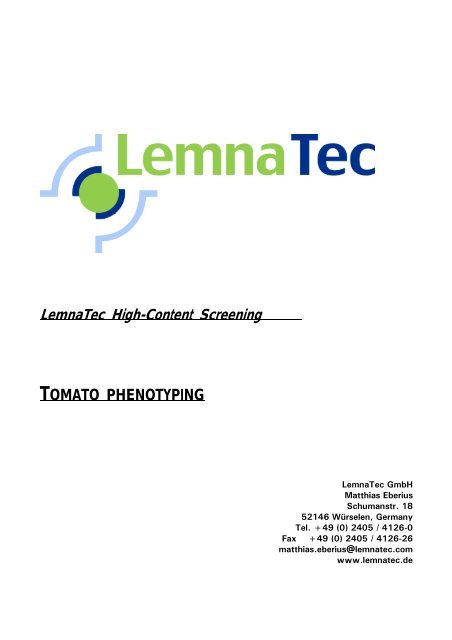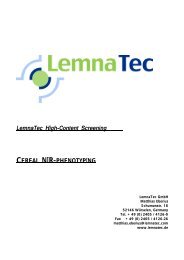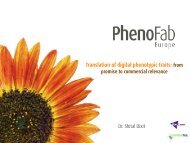Scanalyzer 3D tomato phenotyping - LemnaTec
Scanalyzer 3D tomato phenotyping - LemnaTec
Scanalyzer 3D tomato phenotyping - LemnaTec
You also want an ePaper? Increase the reach of your titles
YUMPU automatically turns print PDFs into web optimized ePapers that Google loves.
<strong>LemnaTec</strong> High-Content Screening<br />
TOMATO PHENOTYPING<br />
<strong>LemnaTec</strong> GmbH<br />
Matthias Eberius<br />
Schumanstr. 18<br />
52146 Würselen, Germany<br />
Tel. +49 (0) 2405 / 4126-0<br />
Fax +49 (0) 2405 / 4126-26<br />
matthias.eberius@lemnatec.com<br />
www.lemnatec.de
Why image-based high-content <strong>phenotyping</strong>?<br />
With the steady multiplication of genetic research data, it is getting increasingly<br />
interesting to find correlations between genotypes and phenotypes. Such correlations<br />
make rapid and focussed conventional breeding and validation of genes for efficient<br />
molecular reproduction possible.<br />
To distinguish efficiently between inter- and intra-cultivar variability, the testing of a<br />
greater number of plants is important. But only comprehensive quantitative <strong>phenotyping</strong><br />
provides a sufficient database for biostatistics.<br />
As breeding programs and screenings need to include hundreds or thousands of plants<br />
often grown in different seasons and at places far apart, a reliable and reproducible<br />
measurement of morphological parameters is of utmost importance to produce valid,<br />
comparable and comprehensive data. Image-based <strong>phenotyping</strong> using imaging under<br />
defined conditions provides data with exactly this high standard needed for data mining.<br />
Even if specific, particularly interesting observation parameters are discovered only years<br />
after the start of a certain project or after it has been terminated, the images stored in the<br />
database allow reanalysis of all plants ever used in this assignment.<br />
Each plant that has spent a whole life cycle in a research or breeding greenhouse has in<br />
the end a total value of up to $ 800. Any technical device to extract additional<br />
information from images already stored and available for reanalysis — instead of<br />
performing new tests — can reduce research costs by several $ 100,000 and<br />
simultaneously accelerate breeding of new cultivars.<br />
While all these factors can already be applied to directed breeding research, they have an<br />
even greater importance for culture collections. Here only small amounts of seeds are<br />
available for the routine regeneration of seed quality, and researchers interested in<br />
specific phenotypes are almost by definition scattered all over the world. And they have<br />
usually never seen the plant they are interested in when requesting seed samples.<br />
Comprehensive high-content <strong>phenotyping</strong> may not only include the analysis of the visual<br />
results of regularly grown plants, but can also provide dynamic information, e. g. about<br />
opening and closing dynamics of stomata (based on IR-imaging), as well as showing<br />
reactions under specific stressors (heat, drought, pests etc.).<br />
Plants on conveyor systems are constantly moved in the greenhouse during the day,<br />
minimising hotspots of heat or temperature for growth conditions, so that they can be<br />
completely randomised. This new option immensely reduces plant variability due to<br />
different growth conditions and produces an extremely homogeneous set of background<br />
values. Taking appropriate statistics (mean values, median values, significance tests like ttest<br />
etc.) even allows the detection of small effects attributed to a potentially different<br />
genetic background of a plant. Having such advanced datasets, QTL-methods, for<br />
example, become a very powerful tool to identify the relation between genes and any kind<br />
of development or phenotype trait.<br />
In addition, water usage and watering schemes can be completely and efficiently<br />
controlled by <strong>LemnaTec</strong> watering stations, thus adding another important parameter<br />
(tool?) to comprehensive <strong>phenotyping</strong>.<br />
2
Phenotyping with the <strong>LemnaTec</strong> <strong>Scanalyzer</strong> 3-D and <strong>Scanalyzer</strong> 3-D<br />
Conveyor Technology<br />
<strong>LemnaTec</strong> provides a modular family of plant <strong>phenotyping</strong> units easily adjustable to<br />
customer requirements. The basic principle of all units is to image each plant under<br />
reproducible conditions in a closed imaging box, thus providing vastly comparable images.<br />
Plants are generally imaged from the top and two sides by automatically turning the pot<br />
by 90°. If needed, more than two side images can be taken during each sequence. Plants<br />
are identified automatically by barcode or RFID-technology. Thus a high throughput is<br />
combined with the absolute certainty of not mixing up plants.<br />
Depending on the throughput needed and on greenhouse organisation, <strong>LemnaTec</strong> provides<br />
different types of imaging units. As a rule, plants are imaged several times during their<br />
growth phase to quantify growth and development of important traits in time.<br />
Fig. 1: Every <strong>LemnaTec</strong> Plant <strong>Scanalyzer</strong> 3-D consists of an imaging unit for top and side<br />
images. It can be manually fitted with plants (so richtig?) and is most suitable if only one<br />
imaging mode (mostly VIS imaging) is to be performed at medium or low throughput.<br />
3
Fig. 2: <strong>LemnaTec</strong> <strong>Scanalyzer</strong> 3-D conveyor units include at least a short conveyor belt<br />
that can be loaded with the plants to be imaged. This allows for higher throughput and<br />
sequential imaging in various imaging modes (e. g. VIS and NIR or more). Depending on<br />
the method of application the unit may include automatic doors or shadowing canals.<br />
Fig. 3: With <strong>LemnaTec</strong> <strong>Scanalyzer</strong> 3-D conveyor units and greenhouse management<br />
systems, either the whole or at least part of the greenhouse is additionally equipped with<br />
conveyor belts. Plants stay on the belts for their whole life cycle, being randomised in the<br />
greenhouse when they are not imaged. Such units are particularly suitable for large<br />
numbers of plants in bigger pots and in cases where watering and spraying is<br />
programmed as well.<br />
4
Watering<br />
All types of conveyor belts can be fitted with a watering and weighing station where each<br />
plant is weighed in passing and data of water loss are recorded in the database.<br />
Depending on the programming mode and database entry, water will be added individually<br />
up to a certain total weight to keep the soil water content as constant as possible, or to a<br />
reduced level to induce controlled stress.<br />
VIS imaging<br />
The basic approach to plant <strong>phenotyping</strong> is imaging in visual light. Homogeneous cloudy<br />
day illumination from top and side forms the basis for taking images later to be compared<br />
within and between plants over longer periods (images that can later be compared to find<br />
differences either between or within the plants over extended time spans).<br />
The use of certain high quality colour cameras and zoom lens systems according to<br />
industrial standard, which are completely controlled by configurations stored in the<br />
database, allows highly reproducible imaging. Getting this kind of high reproducibility is of<br />
major importance for the assessment of developments within one plant and the detection<br />
of differences between larger sets of plants.<br />
Cameras have a high sensitivity and customisable special modules can be provided, e. g.<br />
to filter images for continuous chlorophyll fluorescence or GFP (or related fluorescence.).<br />
If multi-spectral images are needed, hyper-spectral filters can also be implemented.<br />
5
Near Infrared Imaging<br />
Near Infrared (NIR) imaging can be used, for example, to get detailed information on the<br />
watering status of plant leaves and their reaction to limited water availability. The<br />
following image shows how a corn plant reacts to drought stress over a period of 8 h.<br />
Corn 0 h<br />
Corn 8 h<br />
Fig. 4: The images show how a corn plant under moderate water stress loses water over<br />
a period of 8 h (top, bottom left). While dark green areas signify a maximum absorption of<br />
NIR light by water (high water content), light areas represented as yellow or red show the<br />
minimum amount of water. The graphs show the absolute development of projected leaf<br />
area (top right) and relative changes over time (bottom right).<br />
While the plant area is still showing growth during the day (but the growth rate is already<br />
dropping towards the end), water content of the leave is significantly decreasing. This<br />
shows that the plant is subject to water deficiency stress, and that this parameter can<br />
efficiently be monitored quantitatively by the <strong>LemnaTec</strong> <strong>Scanalyzer</strong> system.<br />
area class in pixels<br />
% Area class<br />
1400<br />
1200<br />
1000<br />
800<br />
600<br />
400<br />
200<br />
0<br />
100%<br />
90%<br />
80%<br />
70%<br />
60%<br />
50%<br />
40%<br />
30%<br />
20%<br />
10%<br />
0%<br />
0 2 4 6 8<br />
hours<br />
0 2 4<br />
Hours<br />
6 8<br />
6
Results of <strong>phenotyping</strong><br />
Plant <strong>phenotyping</strong><br />
Plants will be imaged from the top and at least from two sides. For <strong>tomato</strong> plants imaging<br />
from all four sides is recommended as each may yield different information and <strong>tomato</strong>es<br />
have no preferred (main, principal) symmetry axis. Depending on the parameter analysed<br />
it can make sense either to calculate average or median values from all four side images<br />
or to add up information in order to get a comprehensive dataset for each plant.<br />
For the sake of better illustration the following images show only one-sided images.<br />
In the first step after imaging, all plant area is segmented from background, sticks and<br />
pot.<br />
The figure below shows the result of such an analysis for a set of morphologically<br />
different plants. The different visible height of the plants is due to different growth as all<br />
were grown in pots of the same size.<br />
1 2 3 4 5 6<br />
Fig. 5: Projected leaf areas of 6 <strong>tomato</strong> plants (1 to 6 from the left) on a side image.<br />
Such images can be analysed for a set of quantitative parameters which in combination<br />
characterise a phenotype, as shown in the following table.<br />
7
Tab. 1: Morphological parameters, derived from a set of test plants, characterising<br />
different phenotypes<br />
Plant 1 2 3 4 5 6<br />
Moment ratio 2,62 1,47 1,24 3,62 3,02 3,04<br />
Plant height total 220 135 188 236 198 137<br />
Height over pot 212 128 142 192 158 116<br />
Height hanging down 8 7 46 44 40 21<br />
Plant width 146 135 221 147 143 109<br />
Projected plant area 9.414 6.843 19.384 15.614 9.269 5.374<br />
Rotational moment 0,404 0,312 0,248 0,287 0,272 0,337<br />
Roundness 1.308 772 837 944 488 282<br />
Compactness 60,3 63,6 72,4 70,8 74,5 76,1<br />
Compactness as quantitatively described above is a parameter that may be used to<br />
quantify the density of leaves. It could be important for optimum light yield or shadowing<br />
between leaves of one plant. Another application could be to describe how fast a plant<br />
can dry up its leaves in the wind, thus avoiding fungal growth caused by high moisture .<br />
The following figure shows a graphic representation of the measured data. Biologically<br />
interesting dimensions of compactness (looking for smaller or bigger areas between leaves<br />
depending on plant morphology) can be parameterised within the software.<br />
Fig. 6: Relation between projected plant area (red) and areas (grey) here parameterised as<br />
being shadowed or being within the plant.<br />
As another approach to plant morphology, it could be interesting to explore at which<br />
height over ground the plant develops which amount of biomass. Leaf areas lower than<br />
pot level may be a pure artefact of growth in pots or a sure sign that certain plants<br />
produce leaves that would – under field conditions – decay on the soil.<br />
8
Fig. 7: The image above shows plants analysed<br />
for projected plant area depending on height over<br />
ground (green to orange). The blue areas show<br />
leaves hanging down below the top level of the<br />
soil.<br />
The graphs shown on the right describe height<br />
profiles for the 6 plants with the same colours as<br />
in the image above.<br />
If it proves interesting, this data type can be<br />
linked to the colour classification of the plant,<br />
quantifying leaf and fruit colour in correlation to<br />
height over ground (not shown).<br />
Leaf and branch <strong>phenotyping</strong><br />
The same <strong>phenotyping</strong> parameters that are used for complete plants (and even more) can<br />
be quantified for cut leaves or branches.<br />
This may reveal additional important traits, as branch morphology is strongly dependent<br />
on the genetic background of the plant.<br />
9
Fruit <strong>phenotyping</strong><br />
Another important option with the <strong>LemnaTec</strong> <strong>Scanalyzer</strong> is fruit <strong>phenotyping</strong>, which could<br />
prove very important to achieve a constantly high fruit quality (e. g. to minimise the<br />
amount of fruits that have to be discarded due to size, shape or coloration).<br />
The following figures show some examples for parameters that can be derived from fruits.<br />
As an example, <strong>tomato</strong>es are classified based on certain parameters.<br />
70000<br />
60000<br />
50000<br />
40000<br />
30000<br />
20000<br />
10000<br />
0<br />
A01<br />
A03<br />
A05<br />
B02<br />
B04<br />
C01<br />
C03<br />
C05<br />
red-green<br />
yellow-green<br />
pale-yellow<br />
yellow<br />
orange<br />
dark orange<br />
red<br />
dark red<br />
0%<br />
A01A02A03A04A05B01B02B03B04B05C01C02C03C04C05<br />
Fig. 8: Colour classification of <strong>tomato</strong>es imaged from the side. Colours were chosen to<br />
permit maximum separation of important differences. Tomatoes are sorted in rows A, B,<br />
C and columns 1 to 6. While the left graph shows the absolute amount of area per colour,<br />
the right one shows the percentages.<br />
100%<br />
90%<br />
80%<br />
70%<br />
60%<br />
50%<br />
40%<br />
30%<br />
20%<br />
10%<br />
10
Fig. 9: Based on a similar colour scheme as shown in the figure above, <strong>tomato</strong>es were<br />
grouped in different classes. Such schemes allow users the interpretation of quantitative<br />
results and separation of objects into self-defined, biologically relevant classes. The<br />
classes are: red, dark orange, orange, yellow, yellow green and red green.<br />
Fig. 10: The figure shows a shape classification by side view, based on grouping of the<br />
first eight factors of an elliptic Fourier transformation of each fruit outline. Such<br />
classifications can provide highly unbiased and differentiated groupings of various objects.<br />
Plant growth dynamics – dynamic <strong>phenotyping</strong><br />
All the parameters shown above and even more can be quantified in time series,<br />
generating dynamic <strong>phenotyping</strong> data for each plant. From such data growth rates, stay-<br />
PC7<br />
PC8<br />
PC6<br />
1,00E+05<br />
5,00E+04<br />
0,00E+00<br />
-5,00E +04<br />
-1,00E +05<br />
-1,50E +05<br />
-2,00E +05<br />
PC1<br />
PC5<br />
PC2<br />
PC4<br />
PC3<br />
11
green periods, flowering periods, ripening dynamics, reactions to stressors (heat, drought,<br />
pests) or nutrients and much more can be extracted.<br />
Data storage and data mining<br />
Having taken all images and analysed them with many different observation parameters,<br />
the resulting data will remain in the database completely linked. This enables users to<br />
perform all kinds of image reanalyses for complete tests at any point of time in the future,<br />
and it even allows the research of completely new aspects. So the whole procedure has<br />
two major advantages over making a range of completely new experiments: It is<br />
dramatically faster as it takes only minutes or hours to get valuable results. And it is<br />
noticeably cheaper, considering that the total costs of a plant having completed a full life<br />
cycle in a greenhouse may range up to $ 800.<br />
The whole database is stored on a speedily accessible array of hard drives on a server<br />
which may be designed to comply with the specific data safety needs of the user (Raid<br />
system, backup strategies).<br />
All data and related images are available for easy data mining with the LemnaMiner. This<br />
interface was specially designed to grant easy access to databases for experts interested<br />
in the results. Staff do not need any specific database skills, thus making them<br />
independent of IT specialist services.<br />
Conclusion<br />
The <strong>LemnaTec</strong> <strong>Scanalyzer</strong> is a comprehensive <strong>phenotyping</strong> platform highly suitable to<br />
quantify morphological traits of <strong>tomato</strong>es (and any other plant) over their whole life cycle.<br />
The examples above just give a first impression of the full capabilities of the system for<br />
quantitatively characterising <strong>tomato</strong>es (and other plants). All results are reproducible<br />
based on biologically relevant parameters.<br />
The <strong>LemnaTec</strong> systems can be customised for various applications and diverse<br />
throughput, depending on the customers’ needs.<br />
For further information please do not hesitate to contact<br />
Matthias Eberius<br />
<strong>LemnaTec</strong> GmbH<br />
Schumanstr. 18<br />
52146 Würselen, Germany<br />
Tel. +49 (0) 2405 / 4126-0<br />
Fax +49 (0) 2405 / 4126-26<br />
matthias.eberius@lemnatec.de<br />
www.lemnatec.com<br />
12





